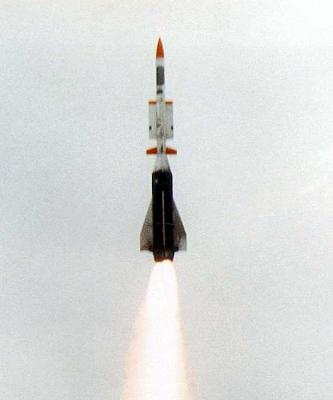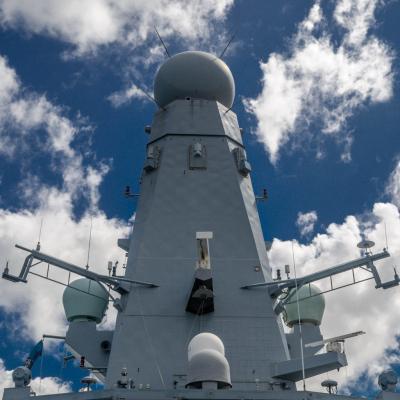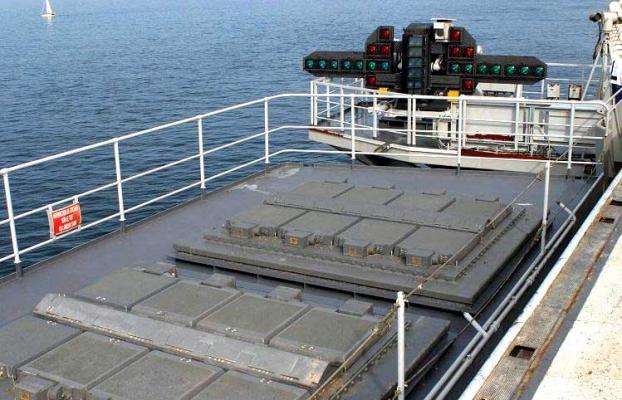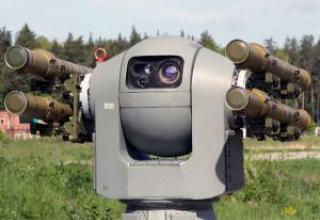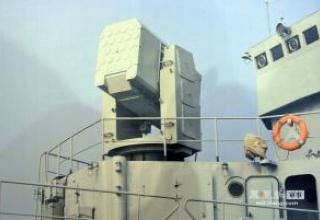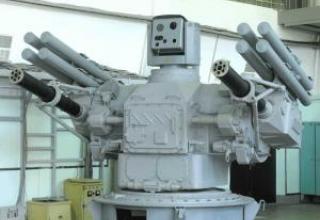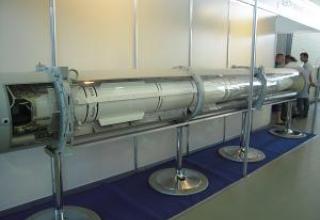PAAMS (Principal Anti-Air Missile System) is one of the family of air defense systems created as a result of the European program FSAF (Forward Surface to Air Family of missile systems). All systems created within the framework of this program are based on common principles implying: modular configuration with wide unification of elements included in different systems, possibility of successive modernization of systems during the whole life cycle, minimal maintenance during operation. The main developer of the FSAF family of complexes is the European consortium EUROSAM, founded in June 1989 by Aerospatiale. "Alenia" and "Thompson-CSF."
The first ship complex of this family was the SAAM (EUROSAM NAVAL System) near-range missile "Aster-15", designed to equip ships of the French Navy (SAAM-FR) and Italy (SAAM-IT). SAAM-FR complex tests were completed in October 2001, SAAM-IT - in December 2002. The SAAM complex is installed on the French "Charles de Gaulle" aircraft carrier, the Italian "Carabiniere" frigate and the French "Ile d'Oleron". The SAAM-FR SAM system with the Aster-15 was adopted for service on the Charles de Gaulle aircraft carrier in December 2001. In May 1997, the first export contract was concluded for the installation of SAAM SAMs on frigates of the Saudi Navy's F-3000S project. Tests on these frigates were successfully completed in 2004.
PAAMS air defense systems are designed to provide air defense of individual ships and formations at ranges up to 100 km and can be equipped with both "Aster-15" and "Aster-30" missiles with extended range. The missiles were developed as universal both on the carriers (land and sea versions) and on the targets to be hit (aerodynamic, aeroballistic, and in the future ballistic). The ground complex was designated SAMP-T. The SAMP-T complex is capable of operating under conditions of intensive interference of different types by the enemy, fighting against aerodynamic targets of all types, as well as destroying anti-ship missiles flying at low altitudes or diving to ships with large angles of attack.
PAAMS SAM development has been singled out as a separate program, where the main contractor is the European consortium EUROPAAMS, formed by EUROSAM consortium and Italian companies "Alenia Marconi Systems" and UKAMS (now a branch of Matra BAe Dynamics, UK).
PAAMS SAMs are installed on French and Italian Horizon type frigates, and PAAMS (S) version on British T45 type destroyer squadrons.
On September 22, 2000, the EUROPAAMS consortium was awarded the first contract for the production of three PAAMS SAM systems and 200 Aster 15 and Aster 30 missiles, which were to be installed on the main ships of new projects: the English destroyer Daring Apr 45, the Italian frigate Bergamini and the French destroyer Forbin (developed under the Horizon program). On March 28, 2002 a new contract was signed, under which EUROPAAMS consortium ordered seven more SAM kits (5 - for Great Britain and one each for France and Italy), as well as from 400 to 500 SAM kits "Aster 15" and "Aster 30".
Composition:
PAAMS SAM consists of:
- the multifunction radar "EMPAR" (or "Sampson" radar in the version PAAMS(S) for the UK Navy);
- Short range "Aster-15" and medium range "Aster-30" SAMs of "Sylver" models A43, A50, A70 ;
- PAAMS C2 information processing and delivery systems.
Multifunctional radar EMPAR of "Alenia Marconi Systems" company was developed for European frigates of new generation "Horizon". Originally the frigates of this type were intended for operation in the Navy of France, Italy and Great Britain, but later Great Britain left the project. The EMPAR radar is a C-band (4-8 GHz) unit with a rapidly changing frequency at 5.6 GHz in main operating mode. The radar uses the principle of compression of pulses of digital signals and a two-stage superheterodyne receiver connected to a unit of several C40 series digital processors from Raytheon. The EMPAR radar has one water-cooled rotating passive electronic scanning antenna with an inclination angle of 30° (see photo). The radar with such an antenna has limited possibilities of action in the conditions of massive air attacks when striking from different directions. However, these limitations are to some extent compensated by the fact that the Aster-30 ASD does not require constant, but only periodic guidance correction in the middle section of the trajectory, and the final approaching section is operated by active radar CNS (AR CNS). All this relieves the EMPAR radar of the need to be in contact with the missile throughout the target intercept process. The EMPAR radar antenna consists of 2,160 transmission elements and forms a 2.6° beam with the ability to control the directional pattern within 45° horizontally and 60° vertically. The radar can simultaneously provide monopulse tracking for 69 high-priority targets and 2,311 low-priority targets, with the desired data rate being adjusted for each target. According to the manufacturer, maintenance of 50 high-priority targets can be provided with such accuracy and speed of data reception that will be sufficient for immediate interception of these targets, though not all targets simultaneously. Some sources estimate that the EMPAR radar is capable of simultaneously controlling up to 24 SSDs in flight. This radar is characterized by the following target detection ranges: 180km for 10-square-metre EPR targets, 120km for 2-square-metre EPR targets, and 50km for 0.1-square-metre EPR targets.
The multifunctional radar "Sampson" was created by the British company "Defence Evaluation" and the research agency DERA. The radar is intended both for detection of surface and air targets, and for correction of the ZUR flight path. The radar operates in E/F band (16 and 3 cm, respectively). The first range is designed for primary detection of air targets (at a range up to 250 km) and sea targets (up to the horizon line). The second one is used to specify target coordinates and correct the trajectory of the SAM system by means of periodically sending control commands to it. The radar phased antenna consists of two round mirrors mounted "back to back" on a common rotating base, with a total of 5200 elements in the 2600 E and F ranges. Each of the elements consumes 10W, the total power of radiation is about 25kW per mirror. There are several channels in each range, which is provided by electronic scanning of the beam and allows you to simultaneously detect up to 2000 targets, accompany 12 of them (including 8 - in the near zone) and correct the trajectory of flight 16 SSD. The mass of the antenna is 4.6 t and its rotation speed is 30 rpm. The antenna is located under a radio-transparent spherical hood, equipped with air conditioning system, which allows to maintain the necessary climatic conditions.
Aster-15" short-range and medium-range "Aster-30" SAGs have a single aerodynamic scheme, they are fully unified and practically differ only in the size of the first acceleration stages. Aster" family directional sounders are equipped with a combined gas-aerodynamic control system PIF-PAF and when pointing at the target implement the so-called "super maneuverability". PIF-PAF is a combined system in which, along with the traditional aerodynamic control surfaces, a special transverse control engine (TCP) is used, located near the mass center of the RSD. Aster-30" LSD is able to withstand overloads of 50g, and at the final stage of the trajectory - up to 62g. The missile is equipped with an active homing radar head (ARGSN) and is capable of hitting targets flying both at low altitude and along an aeroballistic trajectory. The firepower of PAAMS air defense systems is 8 launches in 10 seconds. SAMs are placed in square-section transport and launch containers (TPC), which are loaded at the manufacturing plant. In the transport and launch containers, the missiles are located during the entire lifetime of the vehicle, which facilitates their storage and use.
The algorithm of PAAMS complex action is as follows. An air target is detected by the S1850M long-range detection radar. When the distance to the target is reduced to 250 km, the target is escorted by the multifunction radar PAAMS (if the target is low-flying, it is detected by the PAAMS SAM independently). In the process of target tracking, information about its coordinates is transmitted to the PAAMS C2 information processing and delivery system. When the distance to the target is reduced to the Aster launch range, PAAMS C2 enters the target direction into the missile's control system and issues a command to launch the Aster. After launch, depending on the distance to the target, the Aster's LV moves towards it either by the shortest route (when shooting at short range) or by aeroballistic trajectory. During the entire missile flight, the complex's radar tracks both the Aster and the target, constantly transmitting their coordinates to the PAAMS C2 information processing and distribution system. PAAMS C2 system calculates the trajectory of the LSDS and generates correction commands, which are transmitted to the missile on the radio channel. When the distance between the target and the LSD is reduced to approximately 3-5 km, the AGS is activated on the missile (on command of PAAMS C2), after which the Aster LSD detects the target and intercepts it independently.
The Sylver A43 vertical launcher (VLU), designed only for Aster-15 missiles, was designed to be mounted on the Charles de Gaulle aircraft carrier, the Italian frigate Carabiniere and the French Ile d'Oleron. Saudi Arabia's Riyadh frigates are equipped with two Sylver A43 HPUs with 8 Aster-15 missiles. The A-43 is 5.4m long and weighs 7.5 tonnes.
HPU "Sylver" A50, designed by the French state national shipbuilding company DCN specifically for PAAMS air defense systems and is designed to fire anti-aircraft missiles "Aster-15" and "Aster-30". Wide application of composite materials, low pressure in the gas-dynamic path of the launcher (due to the large free volume caused by the need to place the non-deployable wings of the missile), as well as the use of a simplified amortization system (due to the ability of the SAMs of the "Aster" family to withstand overload of 60g) have led to the creation of a fairly lightweight design. HPU A50 is 6m long and weighs 8t, which is much smaller than the American launcher Mk.41 firm "Lockheed Martin", but does not have the versatility of the latter.
Universal vertical launcher (UVPU), designated "Sylver" A70, is created by DCN specialists for placement on advanced carriers and allows for firing of "Aster" SAMs of various modifications, as well as all types of missiles designed for firing from the U.S. Mk.41 UVPU, including PCR "Scalp", "Tactical Tomahawk" and others. Development of UVPU A70 began in 2004, testing is planned for 2007-2008. On the main destroyer "Daring" Ave. 45 of the UK Navy 6 HPU "Sylver" A50 (each launch has 8 cells) for 48 missiles are installed. Starting from 2010 it is planned to place 8-9 Sylver A70 HEU on the destroyers of this project which are going into service.
Characteristics:
| Features | "Aster-15" | "Aster-30" |
| Aerodynamic target range, km : - minimum - maximum |
1.7 30 |
3 100 (other data 80) |
| Maximum target range of PCR type target, km | 25 | |
| Impact height of targets, m - minimum - maximum |
5 10000 |
5 20000 |
| Maximum speed of ZUR, m/sec | 1000 | 1400 |
| Weight BC, kg | 15-20 | |
| Starting mass ZUR, kg | 300 | 445-510 |
| The marching step: - length, m - diameter,m - weight,kg |
2.6 0.18 100-110 |
|
| Start step : - length, m - diameter,m - wingspan, m - weight,kg |
2.3 0.54 0.92 380-400 |
Testing:
In May 1996 the launches of Aster-15 SAMs on the C-22 target in the mode of active radar homing on the final section of the trajectory began. The target simulated an attack aircraft flying at a speed of 270m/s at an altitude of 1000m. In April 1997, the C-22 target simulating a subsonic anti-ship cruise missile flying at an altitude of 10m was successfully intercepted. The target was intercepted at a range of 7km.
In November 1997, at a range of 7km, the Aster-15 with an inert ballistic missile for the first time hit a target simulating a low-flying SCR. In December 1997, the first successful launches of Aster-15 missiles against real targets were made (including the MM38 "Exocet" PKR intercepted at a range of 9 km).
On December 30, 1997 the first launch of Aster-30 SAM system at real targets. At a range of 30km the missile intercepted a target C-22, flying at a speed of 900km / h at an altitude of about 11000m. During the tests, "Aster-30" reached a speed of 2880 km / h, the miss was less than 4m.
2001г. - The "Aster-15" successfully intercepted a training target simulating an aircraft flying at M=1 speed at an altitude of 100m.
During 2004, three launches of Aster-15 anti-aircraft missiles were made from Saudi Riyadh class frigates at the French test site in the Mediterranean Sea. All targets were hit by a direct hit.
October 7, 2010. The British Navy announced the first firing tests of sea-based SAMs PAAMS(S) on board the squadron of "Daring" type mine carrier pr.45. Aster-30" was launched from the destroyer "Downtless", the missile successfully hit the unmanned target "Mirak-100/5" at the Hebrides test site (west of the Scottish coast). The target flew at 400 knots and a height of over 30,000 feet.
Sources:
- Василин Н.Я., Гуринович А.Л. "Зенитные ракетные комплексы" .-Мн.: ООО "Попурри", 2002- 464с.
- "Sylver vertical launchers "
- "PAAMS - Principal Anti Air Missile System"
- "ASTER hit-to-kill Missile Interceptors"
